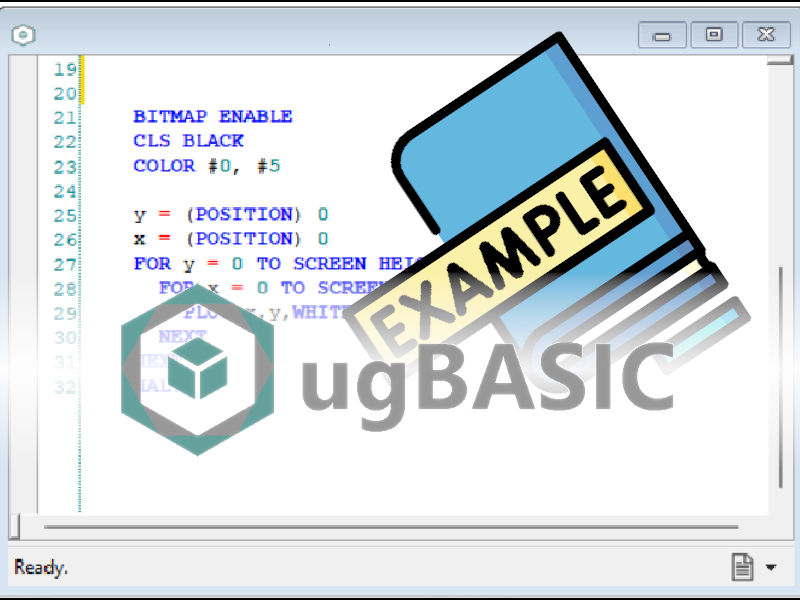SOURCE CODE ( )
)
OPTION EXPLICIT
BITMAP ENABLE (16)
COLOR BORDER BLACK
CLS BLACK
POSITIVE CONST cardColor = WHITE
POSITIVE CONST cardWidth = SCREEN WIDTH / 10
POSITIVE CONST cardHeight = SCREEN HEIGHT / 10
POSITIVE CONST verticalLines = ( SCREEN WIDTH / cardWidth ) + 1
POSITIVE CONST cardXMax = verticalLines - 1
POSITIVE CONST horizontalLines = ( SCREEN HEIGHT / cardHeight ) + 1
POSITIVE CONST cardYMax = horizontalLines - 1
POSITIVE CONST cardEffectiveWidth = cardWidth - 2
POSITIVE CONST cardEffectiveHeight = cardHeight - 2
' DIM colors(16) = #{ _
' BLACK, WHITE, BROWN, LAVENDER, LIGHT BLUE, LIGHT GREEN, LIGHT RED, OLIVE GREEN, _
' PEACH, PINK, VIOLET, DARK BLUE, TAN, MAGENTA, TURQUOISE, YELLOW GREEN _
' }
' DIM primary(16) = #{ _
' DARK RED, RED, LIGHT RED, DARK BLUE, BLUE, LIGHT BLUE, WHITE, BLACK, _
' DARK GREEN, GREEN, LIGHT GREEN, WHITE, TAN, TURQUOISE, YELLOW GREEN, WHITE _
' }
DIM primary2(16) = #{ _
DARK RED, RED, LIGHT RED, DARK BLUE, BLUE, LIGHT BLUE, WHITE, BLACK, _
DARK GREEN, GREEN, LIGHT GREEN, WHITE, BROWN, LAVENDER, OLIVE GREEN, WHITE _
}
PROCEDURE drawLines
DIM lineIndex AS BYTE
FOR lineIndex = 1 TO ( horizontalLines - 1 )
LINE 0, lineIndex * cardHeight TO (SCREEN WIDTH - 1), lineIndex * cardHeight, cardColor
NEXT lineIndex
FOR lineIndex = 1 TO ( verticalLines - 1 )
LINE lineIndex * cardWidth, 0 TO lineIndex * cardWidth, (SCREEN HEIGHT - 1), cardColor
NEXT lineIndex
END PROCEDURE
PROCEDURE drawColors
' SHARED colors, primary, primary2
SHARED primary2
DIM colorIndex AS BYTE
DIM cardX1 AS POSITION
DIM cardY1 AS POSITION
DIM cardX2 AS POSITION
DIM cardY2 AS POSITION
cardX1 = cardWidth + 1
cardY1 = 1
cardX2 = cardX1 + cardEffectiveWidth
cardY2 = cardY1 + cardEffectiveHeight
FOR colorIndex = 0 TO UBOUND( primary2 ) - 1
IF colorIndex = 8 THEN
cardX1 = cardWidth + 1
cardX2 = cardX1 + cardEffectiveWidth
ADD cardY1, cardHeight
ADD cardY2, cardHeight
ENDIF
IF colorIndex = 0 OR colorIndex = 8 THEN
LOCATE 0, ( cardY1 / FONT HEIGHT ) + 1 : PRINT " COLORS "
ENDIF
BAR cardX1, cardY1 TO cardX2, cardY2, primary2( colorIndex )
ADD cardX1, cardWidth
ADD cardX2, cardWidth
NEXT
END PROCEDURE
PROCEDURE drawGreys
DIM cardX1 AS POSITION
DIM cardY1 AS POSITION
DIM cardX2 AS POSITION
DIM cardY2 AS POSITION
cardY1 = 3*cardHeight + 1
cardX1 = 2*cardWidth + 1
cardY2 = cardY1 + cardHeight - 2
cardX2 = cardX1 + cardEffectiveWidth
LOCATE 0, ( cardY1 / FONT HEIGHT ) + 1 : PRINT " GREY"
BAR cardX1, cardY1 TO cardX2, cardY2, DARK GREY
ADD cardX1, cardWidth
ADD cardX2, cardWidth
BAR cardX1, cardY1 TO cardX2, cardY2, GREY
ADD cardX1, cardWidth
ADD cardX2, cardWidth
BAR cardX1, cardY1 TO cardX2, cardY2, LIGHT GREY
ADD cardX1, cardWidth
ADD cardX2, cardWidth
cardX1 = 3*cardWidth + 1
cardX2 = cardX1 + cardEffectiveWidth
ADD cardY1, cardHeight
ADD cardY2, cardHeight
LOCATE 0, ( cardY1 / FONT HEIGHT ) + 1 : PRINT " WHITE"
BAR cardX1, cardY1 TO cardX2, cardY2, DARK WHITE
ADD cardX1, cardWidth
ADD cardX2, cardWidth
BAR cardX1, cardY1 TO cardX2, cardY2, WHITE
ADD cardX1, cardWidth
ADD cardX2, cardWidth
BAR cardX1, cardY1 TO cardX2, cardY2, LIGHT WHITE
ADD cardX1, cardWidth
ADD cardX2, cardWidth
END PROCEDURE
PROCEDURE drawMonoscope
CIRCLE SCREEN WIDTH / 2, SCREEN HEIGHT / 2, MIN( SCREEN WIDTH / 2, SCREEN HEIGHT / 2 ), cardColor
END PROCEDURE
drawLines[]
drawColors[]
drawGreys[]
drawMonoscope[]


